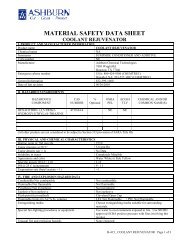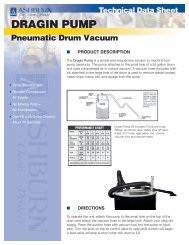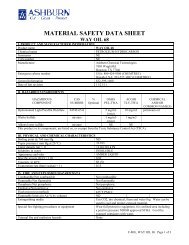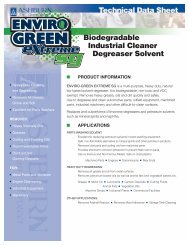MSDS AW46 - Ashburn Chemical Technologies
MSDS AW46 - Ashburn Chemical Technologies
MSDS AW46 - Ashburn Chemical Technologies
Create successful ePaper yourself
Turn your PDF publications into a flip-book with our unique Google optimized e-Paper software.
MATERIAL SAFETY DATA SHEET<br />
HYDRAULIC OIL <strong>AW46</strong><br />
I. PRODUCT AND MANUFACTURER INFORMATION<br />
Product name<br />
HYDRAULIC OIL <strong>AW46</strong><br />
<strong>Chemical</strong> name<br />
PETROLEUM OIL<br />
Synonyms<br />
LUBRICATING OIL<br />
CAS number<br />
NE<br />
Manufacturer<br />
<strong>Ashburn</strong> <strong>Chemical</strong> <strong>Technologies</strong><br />
7403 Wright Rd<br />
Houston, TX 77041<br />
Emergency phone number<br />
General Information 832-399-1000<br />
Date of last revision 3/6/11<br />
II. HAZARDOUS INGREDIENTS<br />
USA: 800-424-9300 (CHEMTREC)<br />
Outside USA: 703-527-3887 (CHEMTREC)<br />
HAZARDOUS<br />
COMPONENT<br />
CAS<br />
NUMBER<br />
%<br />
Optional<br />
OSHA<br />
PEL<br />
ACGIH<br />
TLV<br />
CHEMICAL AND/OR<br />
COMMON NAME(S)<br />
Severely hydrotreated heavy<br />
64742-52-5 5 mg/m3<br />
naphthenic distillate<br />
Zinc C1-C14 alkydithiophosphate 68649-42-3<br />
III. PHYSICAL AND CHEMICAL CHARACTERISTICS<br />
Boiling point @ 760 mm Hg<br />
400 C<br />
Vapor pressure at 20 °C<br />
ND<br />
Vapor density (air = 1)<br />
ND<br />
Solubility in water<br />
INSOLUBLE<br />
Appearance and odor<br />
PALE YELLOW TO AMBER LIQUID<br />
Specific gravity (H 2 O = 1.0) 0.89<br />
Melting point<br />
ND<br />
Evaporation rate (butyl acetate = 1)
Hazardous polymerization will/will not occur<br />
and or nitrogen.<br />
Will not occur.<br />
VI. HEALTH HAZARD DATA<br />
Threshold limit value<br />
Primary route(s) of entry<br />
Known Hazards Under 29 CFR 1910.1200<br />
Mutagenic (genetic defects)<br />
Reproductive<br />
Systemic<br />
Teratogenic (birth defects)<br />
Carcinogen listed in:<br />
NTP (National Toxicology Program)<br />
IARC Monographs<br />
OSHA<br />
Signs and symptoms of exposure<br />
Inhalation<br />
Skin contact<br />
Eye contact<br />
Ingestion<br />
Emergency first aid procedures<br />
Inhalation<br />
Skin contact<br />
Eye contact<br />
Ingestion<br />
Medical conditions generally aggravated by<br />
exposure<br />
Notes to physician<br />
Skin<br />
None<br />
None<br />
None<br />
None<br />
NO<br />
NO<br />
NO<br />
In elevated temperatures or in enclosed spaces, product mist or vapors may<br />
irritate the mucous membranes of the nose, throat, bronchi, and lungs.<br />
This product may cause mild skin irritation from prolonged skin contact.<br />
Injection into the skin, muscle or blood stream requires immediate medical<br />
attention.<br />
This product can cause transient eye irritation with short term contact with<br />
liquid sprays or mists.<br />
If ingested, no significant adverse health effects are anticipated. Ingestion<br />
can cause mild irritation to the digestive tract or cause a laxative effect. If<br />
aspirated into the lungs, the material can cause severe lung damage or death.<br />
Move victim to fresh air. If victim is not breathing, begin artificial<br />
respiration. If breathing is difficult, 100% humidified oxygen should be<br />
administered by a qualified individual. Seek immediate medical attention.<br />
Remove contaminated shoes and clothing. Wipe off excess material. Wash<br />
exposed skin with soap and water. Seek medical attention if tissue appears<br />
damaged or if irritation persists. Thoroughly clean clothing before re-use.<br />
Discard contaminated leather goods. Injection into the skin, muscle or blood<br />
stream requires immediate medical attention.<br />
Check for and remove contact lenses. Flush eyes with cool clean low<br />
pressure water while occasionally lifting and lowering the eyelids. Seek<br />
medical attention if excessive tearing, redness, or pain persists.<br />
Do not induce vomiting unless directed by a physician. Do not give<br />
anything to drink unless directed by a physician. Never give anything by<br />
mouth to person that is unconscious. Seek medical attention immediately.<br />
Personnel with pre-existing skin disorders should avoid repeated or<br />
prolonged contact with this product.<br />
In the event of injection into underlying tissue, immediate treatment should<br />
include extensive incision and saline irrigation. Inadequate treatment can<br />
result in eschemia and gangrene. Early symptoms may be minimal.<br />
VII. PRECAUTIONS FOR SAFE HANDLING AND USE<br />
Steps to take if released or spilled<br />
Treat as an oil spill. Dike area. Clean up with absorbent material. Do not flush<br />
into drain or sewers. Place in a DOT approved container for disposal.<br />
Waste disposal method<br />
According to federal, state and local regulations.<br />
F-846_ HYDRAULIC OIL <strong>AW46</strong> msds Page 2 of 3
Precautions for handling and storing<br />
Other precautions<br />
Hazard ratings HMIS NFPA<br />
Health 1 1<br />
Flammability 1 1<br />
Reactivity 0 0<br />
Personal protection<br />
B<br />
VIII. CONTROL MEASURES<br />
Protective gloves (type and material)<br />
Eye protection<br />
Other protective clothing or equipment<br />
Respiratory protection (specify type)<br />
Ventilation and conditions<br />
Local<br />
Mechanical<br />
Other<br />
Special<br />
Work/hygienic practices<br />
Use gloves that are chemical resistant such as neoprene or nitrile rubber.<br />
Use safety glasses with side shields or goggles or face shield if splashing or<br />
spraying is anticipated.<br />
Impervious protective clothing. e.g. Tyvek.<br />
None normally required. If TLV is exceeded, use NIOSH approved respirator.<br />
General room ventilation should be satisfactory. Local exhaust ventilation may<br />
be necessary if misting is generated.<br />
Launder contaminated clothing before reuse. Avoid prolonged breathing of<br />
mist and vapors. Use as directed. Normal precautions common to good<br />
manufacturing should be followed in handling and storing. Store away from<br />
food. Wash hands before eating, drinking, or smoking.<br />
IX. ADDITIONAL REGULATORY INFORMATION<br />
SARA hazard category (Section 311 and Delayed (Chronic) Health Hazard<br />
312 of the Superfund Amendment and<br />
Reauthorization Act of 1986 (SARA Title<br />
III)<br />
Toxic chemical(s) subject to the supplier NONE<br />
notification requirements of section 313 of<br />
the Superfund Amendment and<br />
Reauthorization Act of 1986 (SARA) and<br />
the requirements of 40 CFR part 372<br />
Ingredient(s) regulated under the Clean Air NONE<br />
Act Section 112 hazardous air pollutants<br />
and subject to all reporting requirements of<br />
CERCLA (Superfund)<br />
NA – not applicable NR – not reported ND – not determined NE – not established UN – unknown<br />
The information presented in this <strong>MSDS</strong> has been compiled from sources deemed reliable. This <strong>MSDS</strong> is presented in good<br />
faith and believed to be accurate as of the effective date shown above. No warranty, expressed or implied, is given.<br />
Regulatory requirements are subject to change and may differ from one location to another. It is the responsibility of the<br />
buyer to insure compliance with federal, state, provincial and local laws and regulations.<br />
F-846_ HYDRAULIC OIL <strong>AW46</strong> msds Page 3 of 3
















